Welcome to
MIDDLESBROUGH Environment City
Rooted in Nature was a project supporting wellbeing for those referred to us via their GPs, by providing them with advice, care and general guidance, as well as nature-based activities and other such activities to help improve wellness.
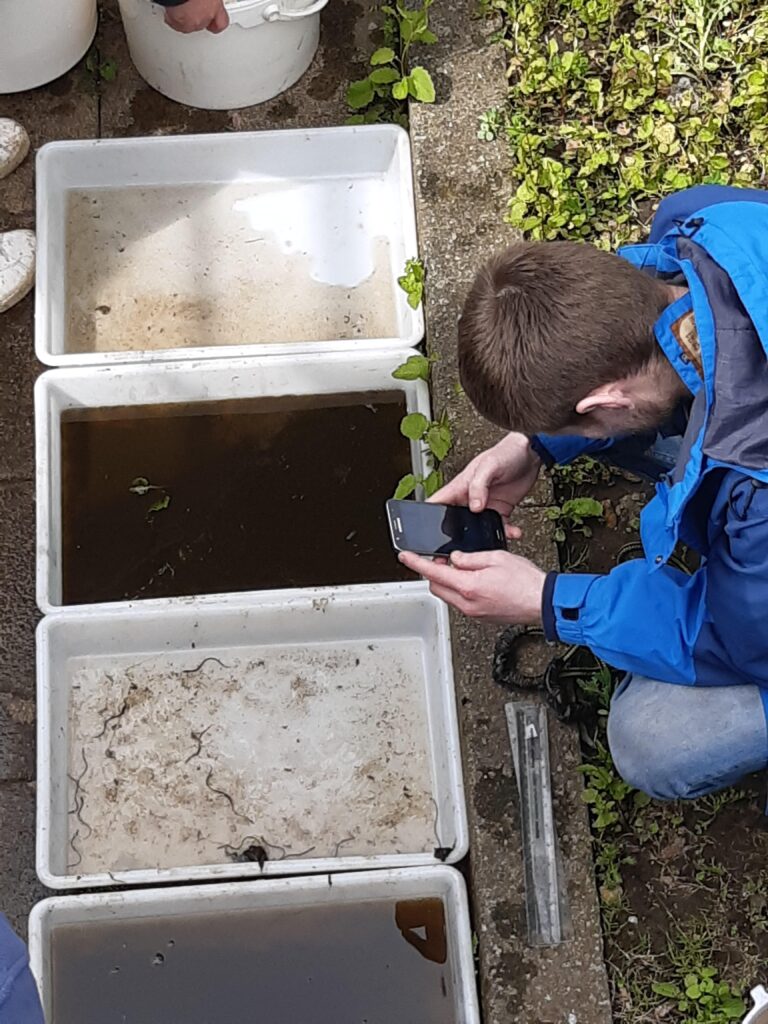
Thr project offered one to one support and advice to individuals and families with mental health needs. Despite the activities being nature-based, no experience, skills or knowledge was needed to take part in any of the activities provided. The activities include:
- walk and talk groups
- basket weaving
- wood work
- growing and planting foods
- gardening
- conservation
- campfire cooking
- meditation
This project was delivered in partnership with Middlesbrough and Stockton MIND, Barefoot Kitchen, The Wildlife Trust (Tees Valley), Youth Focus North East and the Better Health at Work Award. The activities we delivered across Teesside included at our head offices here on the site of the old Nature’s World in Acklam, Fairy Dell, Newham Grange Farm, the Tees Barrage and more.

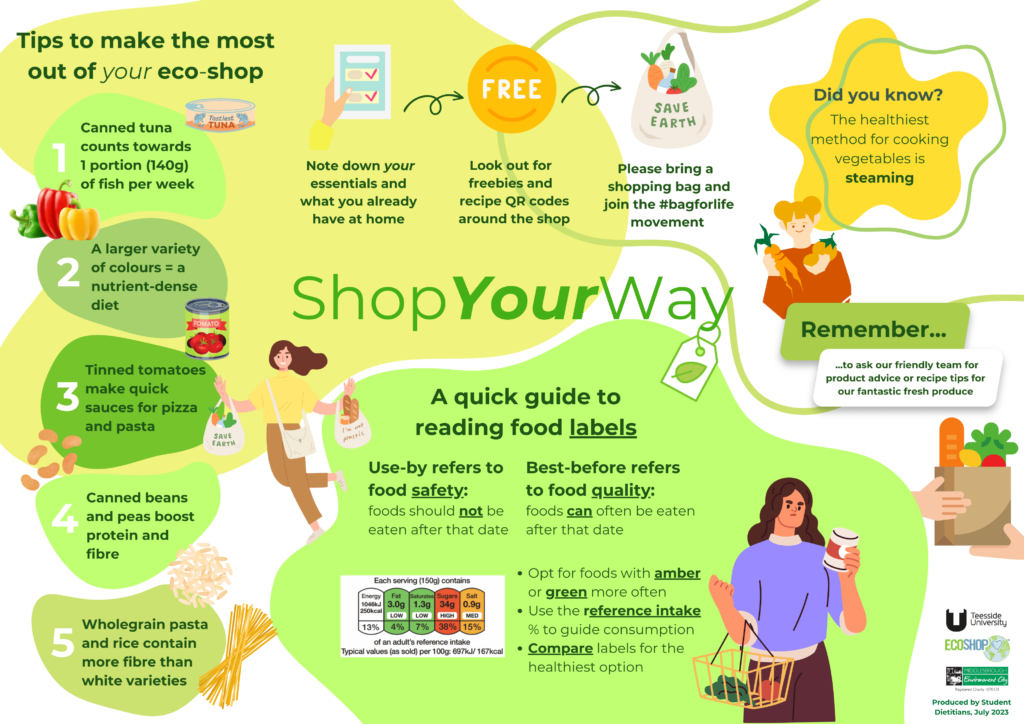
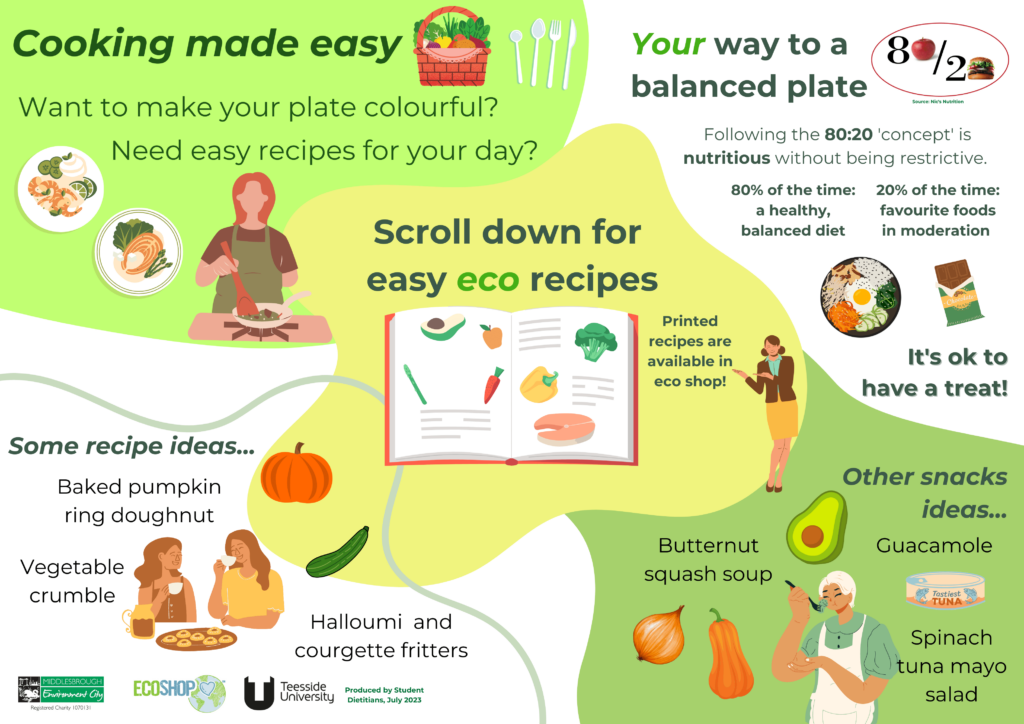

Curried celeriac (serve with rice) (serves 4)
- 1 large celeriac peeled and cut into 3cm cubes
- 3 tablespoons vegetable oil
- 1 tablespoon cumin seeds
- 2 teaspoons coriander seeds lightly crushed
- 2 teaspoons ground turmeric
- 1 jar curry sauce
- Heat the oven to 200°C/fan 180°C/gas mark 6. Spread celeriac cubes into a baking tray and mix with 1 tablespoon of the vegetable oil and some seasoning. Toss again with cumin, mustard seeds, coriander seeds, turmeric and pepper until the celeriac is well coated. Roast for 30 minutes, turning halfway through, until the celeriac is slightly caramelised and cooked through.
- Heat the pan and pour curry sauce into it, cook according to pack instructions. Add cooked celeriac and give it a stir until the sauce is slightly thickened. Serve with rice.
Nutritional value:


Spinach tuna mayo salad (serves 4)

- Spinach 1 pack
- Tuna canned, approximately 145g
- Sweet corn 4 tablespoons
- Mayo 2 tablespoons
- Steam spinach for 2 minutes, then put aside to cool it down
- Mix all the ingredients and serve
Serve as a side to pot noodles or jacket potatoes!
Nutritional value:


Creamy mushroom and spinach pasta (serves 2)

- 2 tablespoons oil
- 1 onion finely chopped
- 150g mushrooms sliced
- 150g pasta
- 2 garlic cloves crushed
- Half jar white pasta sauce, approximately 200g
- 120g baby spinach
- Boil the pasta according to package instructions.
- Heat the oil in a pan, fry onion and mushroom in medium heat until they turn soft and golden brown.
- Add garlic and pasta sauce, stir to combine.
- Add baby spinach and cooked pasta and cook on a low heat until spinach wilts (it usually takes 5 minutes).
- Season with black pepper before serving.
Nutritional value:


Creamy spinach chicken (serve with potatoes) (serves 4)

- 30g unsalted butter/ spread
- 1 pack (240g) baby spinach
- 4 chicken breast fillets sliced into bite-size
- 4 garlic cloves minced
- 150 ml double cream
- 30g grated cheese
- Serve with rice/ potatoes (optional)
- Melt the butter in a pan at medium heat. Fry chicken until it turns golden.
- Add garlic and spinach until spinach wilts. Pour in cream and simmer for 15 minutes until chicken is cooked through
- Add the cheese and stir. Simmer for another 5 minutes until the cheese is melted and chicken is cooked (check to see if meat juice is clear when cutting the meat). Ready to serve.
Nutritional value:


Guacamole (serves 4)

- 1 large tomato, finely chopped
- 3 ripe avocados, not bruised.
- 1 large lime, juiced
- Handful coriander (optional)
- 1 small red onion chopped
- Pinch of black pepper
- Halve the avocados (saving the stone) and use a spoon to scoop out the flesh into the bowl.
- Add finely chopped tomato, lime juice, a handful of roughly chopped coriander, 1 finely chopped small red onion and grind a little bit of black pepper into the bowl, then season with salt.
- Use a fork to mash everything together. If not serving straight away, sit the stone in the guacamole (this helps to stop it going brown), cover with cling film and chill until needed.
Nutritional value:


Avocado egg toast (serves 2)

- Avocado x 1
- 2 pieces of toast
- 2 eggs
- Cut the avocado into half and remove the stone. Slice avocado and put it on top of toast.
- Cook eggs in any style you would like to have – boiled egg, fried egg, scrambled egg, put it on top of avocado and serve.
Nutritional value:


Courgette curry (serves with rice) (serves 4)

- 3 medium courgettes
- 2-3 tablespoons sunflower oil
- 1 red onion, sliced into tiny pieces
- 1-2 red chillies (optional), finely chopped
- 1 tablespoons of minced ginger
- 4 garlic cloves finely grated
- 2 teaspoons garam masala
- 1 teaspoon ground cumin
- 1 teaspoon ground turmeric
- 400g can chickpeas, drained
- 400g can tomatoes
- 400g can coconut milk
- cooked basmati rice, to serve.
- Cut off the two ends of the courgette and then cut the courgette in half. Scrape out the seeds using a spoon and set aside for later. Roughly slice the courgette.
- Heat a pan with oil at a medium heat and fry the sliced courgettes until golden for about 8-10 minutes. Take out the courgette and set aside.
- In the same pan, add the onion, pinch of salt and pepper. Add a further tablespoon of oil if necessary. Fry for 6-8 minutes until soft and golden brown. Pour in chillies, ginger and garlic, and cook for 2 minutes until they are soft. Stir in the spices and cook for another 30 seconds.
- Pour in the drained chickpeas, canned tomatoes, coconut milk and reserved courgette seeds. Cover the lid and simmer over a medium-low heat for 10 minutes. Add the courgettes back to the pan and cook for a further 8-10 minutes. Serve with basmati rice and sides of your choice.
Nutritional value:


Smoked mackerel, courgette and butter beans salad (serves 2)

- 1 lemon juiced
- 1 Mackerel tinned 125g (or any kind of fish can)
- 1 courgette (cut into ribbons using vegetable peelers
- 1 butter beans, canned 400g (drained and rinsed)
- 3 tablespoons oil
- Cheese (optional)
- Add all the ingredients into a salad bowl and gently mix.
Nutritional value:


Halloumi & Courgette Fritters (makes 6-8)

- 2 medium courgette sliced
- 30g self-raising flour
- 20g rice or cornflour
- Quarter teaspoon black pepper
- 80g halloumi cheese grated
- 2 large eggs
- Mix the courgette slices with salt and drain for 30 minutes. Squeeze out liquid to make courgette as dry as possible.
- Stir courgette, flour, black pepper, halloumi and egg into a thick batter.
- Heat the pan with oil and coat the pan base. Add 2 tablespoons of batter for each fritter and flatten it down with spatula. Fry one side of the fritter for several minutes until it turns golden. Flip them over and fry for another several minutes until another side also turns golden brown. Drain on kitchen paper before serving.
Nutritional value:


Beans Broccoli Bake (Serves 4)

- 2 broccoli cut into florets
- 1 onion chopped
- 1 garlic clove minced
- 30g butter
- 1 butter beans/ chickpeas canned 400g drained and rinsed
- Pinch of salt
- Pinch of pepper
- 40g cheddar cheese grated
- 3 tablespoons dry breadcrumbs
- Boil broccoli in water until it turns soft (it usually takes 5-8 minutes).
- Heat the pan with half of butter, fry onion and garlic and spread them onto baking dish.
- Drain cooked broccoli and add to the baking dish. Top with drained beans, salt, pepper, cheese and bread crumbs.
- Melt the remaining butter and pour over the top.
- Bake at 190°C, 375°F or gas mark 5 for 20-25 minutes.
Nutritional value:


Chicken broccoli casserole (serves 4)

- 1 tablespoon oil
- 1 onion chopped
- 2 garlic cloves minced
- 500g chicken breast fillets cut into bite-sized pieces
- Pinch of salt
- Pinch of black pepper
- 300 ml chicken stock
- 100 ml single cream
- 2 broccoli chopped
- 40g grated cheddar
- 200g white rice
- Heat the pan with oil. Add onion and cook for 5 minutes until soft. Add garlic and cook for 1 more minute until fragrant.
- Add chicken, pinch salt and black pepper into pan and cook for around 6 minutes until chicken turns golden.
- Add rice, double cream and 200 ml chicken stock. Cover the pan with lid and simmer for 15-20 minutes until rice turns tender.
- Add the remaining 100 ml chicken stock, broccoli and cheese and cook until broccoli is tender (about 5-10 minutes).
Nutritional value:


Butternut squash soup (serves 4)

- 1 butternut squash cut into large cubes (about 4 cm)
- 2 tablespoons oil
- 1 tablespoons butter/ spread
- 2 onions diced
- 1 garlic clove minced
- 2 mild red chillies finely chopped (optional)
- 850 ml vegetable stock
- 4 tablespoons crème fraîche
- Put the large butternut squash cubes into a roasting tray with 1 tablespoon oil. Roast them for around 30 minutes, turn once halfway through, until they are tender and soft.
- Melt butter/ spread with 1 tablespoon oil in a large pan. Add onions, garlic clove and chilli (optional). Cover with lid and cook at low heat for 15-20 minutes until onions turn soft.
- Put roasted butternut squash into the pan, and also stock and crème fraîche. Blend all ingredients with a stick blender until smooth.
- Reheat the soup in the pan and season to taste before serving.
Nutritional value:


Butternut squash mac and cheese (serves 4)

- 1 butternut squash diced into 3cm pieces
- 2 tablespoons oil
- 350g macaroni/ any small pasta
- 30g unsalted butter/ spread
- 30g plain flour
- 300 ml milk
- 1 teaspoon English mustard
- 100g mature cheddar grated
- 100g parmesan finely grated
- Heat the oven to 200C/fan 180C/gas 6. Put the butternut squash pieces into a baking tray, mix with oil and seasonings, and roast for 25-30 minutes until they are soft. Put the roasted butternut squash into a bowl and mashed until smooth.
- Boil macaroni in water following pack instructions
- Melt the butter in a pan until it is foaming. Add flour and stir while cooking for 2-3 minutes until it is coloured slightly. Add milk little by little while whisking until it turns into a smooth sauce. Heat the sauce at low heat for 5-10 minutes until it is thickened slightly.
- Add mustard, 75g of mature cheddar, 75g parmesan, squash mash and pasta into the sauce and mix well
- Pour the pasta into a baking dish, sprinkle over the remaining cheese and bake for 20-30 minutes until it turns golden. Can serve with green salad.
Nutritional value:


Aubergine pasta with tinned tomatoes and beef mince (serves 2)

- Aubergine x 1
- Onion x 1
- Tinned tomatoes x 1, 400g
- 200g beef minced
- 150g pasta
- 1 garlic clove minced
- Cheese (optional)
- Boil pasta according to the time suggested in package.
- Cut aubergine and onion into pieces.
- Heat the pan with oil, cook aubergine, onion, minced garlic and beef mince until cooked through.
- Add whole tin of tomato and mix well.
- Add cooked pasta and mix well before serve.
- Cheese can be added as optional.
Nutritional value:


Stuffed aubergine with chicken mince (serves 2)

- Aubergine x 1
- 150g chicken minced
- Quarter of an onion
- Pinch of salt
- Pinch of black pepper
- Pinch of flour
- 2 tablespoons mixed herbs
- Wash and cut aubergine into round chunks.
- Cut onion into small dice.
- Mix chicken mince with onion, mixed herbs, salt and pepper until the whole mixture becomes sticky.
- Spread minced meat mixture onto aubergine, and spread flour onto both sides.
- Heat oil in pan, pan-fry aubergine with chicken mince side facing down until it turns golden brown.
- Flip and cook until aubergine are soft, and it is ready to serve.
Nutritional value:


Baked pumpkin ring doughnut (makes 12)

- 150g pumpkin cut into chunks
- 200g plain flour
- 150g light sugar
- 1 teaspoon ground cinnamon
- Half teaspoon ground ginger
- Quarter teaspoon ground nutmeg
- Quarter teaspoon ground allspice
- Three-quarter teaspoon baking powder
- Half teaspoon salt
- 1 whole egg
- 1 egg yolk
- 75 ml sunflower oil
- 1-2 tbsp tablespoons milk (occasional)
- Heat the oven to 200°C/180°C fan/400°F/gas mark 6. Wrap the pumpkin chunks in foil and bake for 30-35 minutes until they are tender. Remove any skin then blend the chunks into pureé. Cool then weigh out 100g.
- Turn the oven down to 180°C/160°C fan/350°F/gas mark 4. Mix flour, sugar, spices, baking powder and 1/2 teaspoons salt in a bowl. Add the eggs, pumpkin purée and oil in another bowl and beat together. Mix the pumpkin mixture into the dry to make a batter. Add milk if you need more moisture in batter.
- Pour the batter into a piping bag or food bag with a corner cut off. Put baking paper on top of a baking tray, pipe the batter onto the baking paper to make a ring doughnut shape. Bake the doughnuts for 10-12 minutes until they are cooked (stick in a cake tester or skewer to see if nothing remains on the stick).
- Transfer them onto a rack and cool down a little before serve.
Nutritional value:


Kale, pumpkin and mince beef stew (serves 4)

- 1 medium pack mince beef (500g)
- 1 tablespoon oil
- 1 pumpkin peeled and cut into small cubes
- 3 shallots, peeled and halved
- 200 ml chicken or vegetable stock
- 1 bag kale finely chopped
- Quarter pack parsley finely chopped (optional or use powder)
- Heat a sauce pan with oil and fry mince beef until it turns brown. Add pumpkin cubes and shallots and cook until pumpkins start to turn brown.
- Add the stock, cover with lid, and simmer for around 15 minutes until pumpkin cubes are tender.
- Add kale and cook for 5 minutes more until it is tender. Mix with parsley and seasonings you like.
Nutritional value:


Vegetable frittata (serves 4)

- 1 bundle of asparagus cut into short pieces
- 2 red onions cut into slides
- 100g mushroom sliced
- 100g spinach
- 50g cherry tomatoes halved
- 8 eggs
- 40g grated cheddar cheese
- Pinch of salt
- Pinch of black pepper
- 2 tablespoons double cream
- Beat the eggs, add double cream, salt and black pepper and mix well.
- Heat the oven-safe pan with oil and fry asparagus, mushroom and red onions until they turn soft. Add Spinach and cook until soft.
- Pour the egg mixture over the vegetables in the pan. Add cherry tomatoes and cheese on the top. Put the pan into the oven and bake until the egg is set.
Nutritional value:


Stir fry chicken with asparagus (with rice/ noodles) (serves 2)

- Chicken breast 200g
- Asparagus 100g
- 2 teaspoon lemon juice
- 2 garlic cloves minced
- Pinch of salt
- Pinch of black pepper
- Cut chicken breast into bite-sized pieces, mix it with salt and pepper.
- Cut off the woody part (the end) of asparagus and cut into similar length as chicken
- Heat oil in the pan. Fry the chicken until it turns golden brown on both sides.
- Add asparagus minced garlic, lemon juice, pinch of salt and pepper and stir fry until asparagus is cooked through.
- Serve with rice or noodles as your choice.
Nutritional value:


Winter vegetable crumble (serves 4)

- 400 ml vegetable stock
- 450g celeriac, peeled and diced
- 3 carrots, peeled and diced // 1 tinned carrot
- 1 onion chopped
- 3 small potatoes, peeled and diced
- 2 leeks, sliced (optional)
- 200 ml tub crème fraîche
- 2 tablespoons plain flour
- 1 tablespoon wholegrain mustard
- 1 teaspoon thyme
Crumble Topping
- 50g butter, diced
- 100g plain flour
- 50g strong cheddar, grated
- 25g flaked almonds
- Pour the stock into a pan and bring to the boil. Tip in the celeriac, carrots and potato, then add the leeks. Cover the pan and cook for 10-15 minutes.
- Beat the crème fraîche with the flour and mustard. Stir into the vegetables until thickened, then add the thyme and season. Remove from the heat.
- For the crumble, rub the butter into the flour. Season, then stir in the cheese and flaked almonds. Spoon the filling into small ovenproof dishes and scatter the crumble on top. If freezing, wrap in cling film, then foil. To defrost, thaw overnight in the fridge.
- To cook, heat the oven to 190°C/170°C fan/gas mark 5 and bake for 30-35 minutes until golden.
Nutritional value:


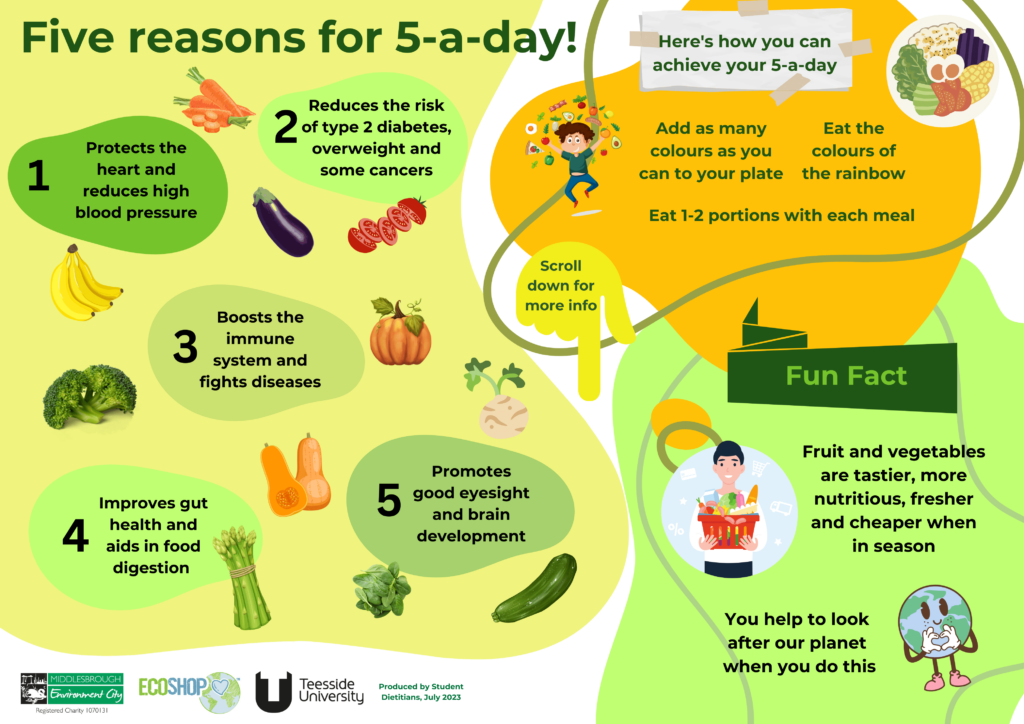
The health benefits of eating fruit and vegetables are numerous. They contribute to a healthy, balanced diet. Therefore consuming at least five portions of fruit and vegetables daily is recommended. Fruit and vegetables are a good source of vitamins and minerals which are required by the body to function properly. They’re an excellent source of dietary fibre, which can help to maintain a healthy gut and prevent constipation and other digestion problems. A diet high in fibre can also reduce your risk of bowel cancer. There is evidence to show that for every portion of fruit and vegetables eaten there is greater protection against heart disease and strokes (by up to 30 per cent), and some cancers (by up to 20 per cent).
Fresh fruit and vegetables are also usually low in fat and calories which help maintain a healthy weight and keep the heart healthy. They contain phytochemicals (naturally occurring plant substances) and powerful antioxidants, protecting the body from harmful free radicals that can cause disease. Other health benefits include a delay in the development of cataracts (cloudy lens of the eye) and age-related macular degeneration, reducing the symptoms of asthma, improving digestive health, better management of diabetes and the potential for improved bone health.
Some commonly found fresh produce in Eco shop and their health benefits.
Celeriac – Good source of fibre for the relief of constipation. It has low glycaemic index which is good for patients with diabetes. Vitamin C for a healthy immune system. Magnesium which supports low blood pressure and improves the work of the nervous system. Phosphorus which helps build strong bones and teeth. Potassium which maintains fluid level in the cell and supports heart muscles. Vitamin K which lowers risk of bone fractures and promotes wound healing.
Broccoli – Contains iron for good blood flow in the body. Good source of calcium for strong bones and teeth. Fibre for gut health and immunity. Folic acid for red blood cell formation. Magnesium which regulates blood glucose level and supports the body to make protein. Phosphorus which helps build strong bones and teeth.
Asparagus – Contains prebiotic for gut health. Rich in folate which helps the body to produce healthy red blood cells. Folate is also important for the development of baby’s brain pregnancy (power brain booster). Good source of potassium which may lower blood pressure. Amino acid supports excess fluid excretion (oedema). Antioxidants which reduce free radicals and slow down ageing.
Courgettes – High fibre and low-calorie count for weight loss. Antioxidants which reduce oxidative stress and likelihood of developing cancer. High source of vitamin B6 which regulates blood glucose. Contains vitamin A for healthy eyes. Also, potassium for heart health and folate for blood formation.
Aubergine – Fibre for digestion. Vitamin A and C– antioxidants which protect cells. Contains Potassium, Calcium, Vitamin k for bone health. Nasunin which helps to manage blood glucose levels. Bioflavonoids for reduction of blood pressure.
Butternut squash – High in vitamin A (beta-carotene and alpha-carotene), vitamin C, Magnesium, Potassium for lower blood pressure and Calcium for strong bones. Can keep one hydrated. Vitamin A is important for normal vision and the immune system. Good source of fibre for weight loss and reduction of risk of cancer. Fibre which helps to manage blood glucose levels by regulating the body’s use of sugar.
Pumpkins – Low calorie for weight loss and diabetes management. Packed with vitamin A protects the body from free radicals which could prevent cancer and other organ diseases. Vitamin A for eyesight, healthy skin, bones, lungs, and kidney. Healthy heart vitamins and minerals such as A, B1, B6, C, Fibre, Folate, Manganese, Calcium, Potassium, and Magnesium. Lowers blood pressure and cholesterol level. Others include E, B2, Iron, Copper.
Kale – Contains Vitamin A for eye, bone, and immunity. Vitamin C for strong immunity. Vitamin K for blood clotting. folate for brain development. More omega-3 than in fish for a healthy heart. Iron for blood formation and proper blood flow. Good source of calcium for strong bones and teeth. Folic acid for red blood cell formation. Lutein for prevention of eye cataracts and great cognition.
Spinach – Contains Iron for good blood flow in the body – healthy blood. Good source of Calcium for strong bone and teeth. Folic acid for red blood cell formation. Potassium for lower blood pressure. Lutein for prevention of eye cataracts and to aid cognition. Vitamin K for bone development. Vitamin A for eye and skin health.
What is a portion?
Both adults and children should eat at least 5 portions of fruits and vegetables every day. A child’s food needs depend on age, body size and levels of physical activity. An adult’s portion of fruit or vegetable is 80g and 30g for dried fruits. As a rough guide, a portion is the amount that can be fit into the palm of the hand, 2 or more fresh fruits, 1 medium fresh fruit, half large fresh fruit, 1 heaped tablespoon dried fruit, 3 tablespoons of vegetables. Tinned or frozen fruit should be the same quantity as the fresh fruits.
Some examples include 5cm cucumber, avocado (half big size and 1 medium size), 1 medium banana, 3 tablespoons diced celeriac, 2 spears 8 florets broccoli, 8 florets of cauliflower, 7 spears asparagus, half large courgette, one-third aubergine, 3 heaped tablespoons diced butternut squash, 3 heaped tablespoons diced pumpkins, 4 heaped tablespoons kale, 4 heaped tablespoons spinach, 1 medium stick or 3 heaped tablespoons diced carrots, 1 medium onion, 14 button or 3-4 heaped tablespoons mushrooms, 1 medium tomato, 7 cherry tomatoes, 1 heaped tomato puree concentrate, 2 whole plum tomatoes, 1 medium apple, 1 medium pears, 14 grapes, 7 strawberries, 2 handfuls (4 heaped tablespoon) blueberries, 1 stick celery.
3 heaped tablespoons of pulses e.g. peas, chickpeas, baked beans etc. one cereal bowl of salad.
For more sample portions, click here: https://www.nhs.uk/livewell/5aday/documents/downloads/5aday_portion_guide.pdf
The quiet walk was great for health, both physical and mental, and provided a way to connect with the great outdoors with getting involved in much hustle and bustle!
We’ll be sharing a lot more from this project in the coming weeks, so keep your eyes peeled: This two year project, which started at the beginning of 2022, is definitely working wonders for those who need it most!

Food For The Planet is a national campaign highlighting, and tackling, the environmental impact of the food industry. It is a campaign of Sustainable Food Places, and is led by the food and farming charity Sustain. It aims to address a key hole in the UK’s commitment to Net Zero by 2050 by focusing on sustainable, local foods: After all, the UK will not reach its commitment to Net Zero by 2050 without transforming how land is used and reducing food waste and consumption of the most carbon-intensive foods.
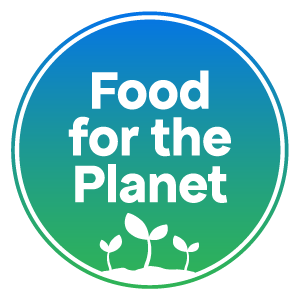
Did you know that the food industry is responsible for around 30% of global greenhouse gas emissions?
Or that a Spaghetti Bolognese made with lentils has only around a third of the carbon emissions of its beef equivalent?
In Middlesbrough, we are working with public sector bodies and others to find ways of reducing their carbon footprint, with a focus on serving less but better meat. From pre-school to elderly care, and in schools and further and higher education, staff are being encouraged to look at their menus to make sure they are not only healthy, nutritious and cost-effective, but also minimise their environmental impact. Through training events, online learning and face-to-face help and advice, organisations throughout the town are being supported to make their catering more sustainable.
Eco Shops are pop-up shops in schools and community venues of high-quality supermarket food. Due to over ordering or mis-printing on the packaging, the food would be thrown away. We want to stop this perfectly good food going to landfill, so it is distributed to Eco-Shops.
Local communities can visit an Eco Shop (with their own shopping bag), and for a donation of £2 can choose 10 items that they want of a range of high-quality supermarket food. The food in Eco Shops changes each week. Mainly Eco Shops will have a wide range of food and drink in tins, jars, packeted and bottles and a range of seasonal fresh fruit and vegetables. Some have chilled and frozen food as well.
Ethos
We do not want to be a part of a wasteful food system: We want to ensure ‘good to eat’ surplus food is being used and not wasted. We want to challenge, and change, the perception of surplus food and the environmental issues around food waste.
Vision
The vision of Eco Shops is to create opportunities for people to help ‘good to eat’ surplus food from being wasted, to challenge and change the perception of surplus food, redefining what can be achieved using surplus food and to change understanding of the environmental issues around food waste.
Background
3.6 million tonnes of food is wasted by the food industry every year in the UK. Over 2 million tonnes of the food that goes to waste each year is still edible. That’s enough for 1.3 billion meals.
In 2018, Middlesbrough’s Park End Primary School worked with Middlesbrough Environment City to develop a project that helped tackle the growing levels of surplus and food waste by making it available to families of pupils of their schools. Surplus food was delivered by FareShare NE, who are part of a global movement who redistribute fresh in date and good to eat surplus from the food industry, which would otherwise go to waste.
The school’s pupil Eco Squad ran a pop-up shop (which they called an Eco Shop) once a week, making the surplus food delivered by FareShare available to families of pupils for a donation of £2 for 10 items, with some fresh fruit and vegetables free. The pupils embraced the environmental ethos of the project and encouraged parents to bring their own shopping bags.
News of the success of the Eco Shop model soon spread and more schools, including secondary schools started to open their own Eco Shops. Community venues also expressed an interest in establishing Eco Shops, providing opportunities for the wider community to help tackle surplus food and food waste. They also worked with local organisations and customers to create and distribute recipes for products that they might not normally choose but wanted to try.
Eco Shops are empowering local people and organisations to come together and make a difference both locally within their community and globally in tackling food waste. They have become extremely popular across Middlesbrough, with new Eco Shops establishing all the time, and now shops are opening across the North East.
The principles, ethos and vision of Eco Shops have been co-designed in partnership with Eco Shop hosts, Middlesbrough Environment City, FareShare NE and the Middlesbrough Food Partnership. All Eco Shops follow core principles but then add their own twist to their shop, making it work the best for their customers.
Find out more about Ecoshops at https://ecoshop.org.uk/


Middlesbrough Food Partnership acts as a central connecting network and hub for all food-related matters in Middlesbrough. Its vision is to make the town a place where local people can eat good quality, healthy food that is easy to buy, offers value for money and is produced locally wherever possible.
For more information about Middlesbrough Food Partnership, visit their website by clicking the image below.


Latest News
Congratulations to Alex and to Middlesbrough Food Partnership for securing the prestigious Sustainable Food Places Gold Award!
Their hard work, determination and countless months of preparation, hard work, sleepless nights and general toil from the Partnership's partners has led to this moment. Unveiled alongside friends such as Tees Valley Together CIO, Groundwork NE & Cumbria, Boro Doughnut and Climate Action Middlesbrough, the Gold Award is a testament to the dedication and hard work undertaken by the Partnership.
The award means that Middlesbrough is now the first town in the North of England, only the fifth overall, to receive the prestigious award! Well done to Alex and the Middlesbrough Food Partnership!Middlesbrough Becomes First Town in the North to Win Prestigious Sustainable Food Places Gold Award! ⭐
Middlesbrough has made history by becoming the first town in the north of England and one of only five places across the UK to be awarded the prestigious Sustainable Food Places (SFP) Gold Award. This achievement is a testament to the town's outstanding efforts in transforming its local food system, led by the Middlesbrough Food Partnership.
The SFP Gold Award recognises exceptional work in creating sustainable, healthy, and accessible food systems that benefit both people and the environment. The award celebrates Middlesbrough’s ability to foster strong connections between strategic planning and grassroots action, driving significant positive changes in the way food is produced, distributed, and accessed.
A key factor in this success has been the dedication of the Middlesbrough Food Partnership, whose tireless efforts have turned ambition into reality. Our work has been recognised for deftly balancing a strong strategic approach with genuine grassroots support, demonstrating how sustainability and food access can work hand in hand. The partnership has also forged meaningful collaborations with academia, research funding, and public health, further strengthening their impact.
“Partnership working across all sectors is how we can help can make a healthier and more sustainable food environment accessible for communities in our area. This award acknowledges our working together across multiple sectors to enhance the local food offer. We look forward to working together to address the need to create healthier and sustainable food for our communities in Middlesbrough” – Amelia Lake, Professor of Public Health Nutrition at Teesside University and Associate Director of Fuse, the Centre for Translational Research in Public Health.
This accolade places Middlesbrough at the forefront of food sustainability, joining only four other places in the UK to be recognised with Gold status. It highlights the town’s commitment to tackling food insecurity, promoting healthy eating, and supporting local food producers, setting an inspiring example for other towns and cities across the country.
Cllr Peter Gavigan, Middlesbrough Council’s Executive member for Environment and Sustainability, congratulated everyone involved in the partnership. He said: “So much hard work has gone into this achievement and it’s fantastic for our town to be recognised in this way. I’ve seen the positive impact that organisations like FareShare North East, Middlesbrough Environment City and the network of Eco Shops have around the town. This work is so important.”
The next steps for Middlesbrough will be to celebrate and engage the community in this remarkable achievement.
(Photo: Members of Middlesbrough Food Partnership; Credit: Phil Russell)
For more information please contact Alex Young - alex.young@menvcity.org.uk
Middlesbrough Environment City | Teesside University | Middlesbrough Council | Climate Action Middlesbrough | Middlesbrough College | Thirteen | Groundwork NE & Cumbria | Regeneration of Communities | Tees Valley Together 🤝 | Boro Doughnut |
#middlesbroughfoodpartnership #middlesbrough #goldaward #boro #teesside #sustainablefoodplaces ... See MoreSee Less
Upcoming Events
12
Nov
Communities Growing Together - Volunteer Session @ Sandy Flatts Community Garden
VIEW14
Nov
Communities Growing Together - Volunteer Session @ Town Farm Community Allotment
VIEW14
Nov
Communities Growing Together - Edible Forest Garden Group
VIEW21
Nov
Communities Growing Together - Volunteer Session @ Town Farm Community Allotment
VIEW21
Nov
Communities Growing Together - Edible Forest Garden Group
VIEW22
Nov
Communities Growing Together – Volunteer Action Day @ Regeneration of Communities
VIEW